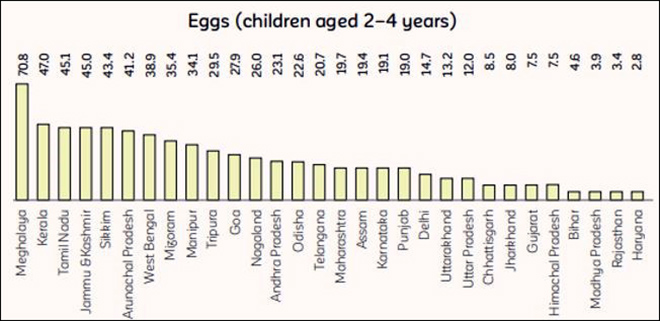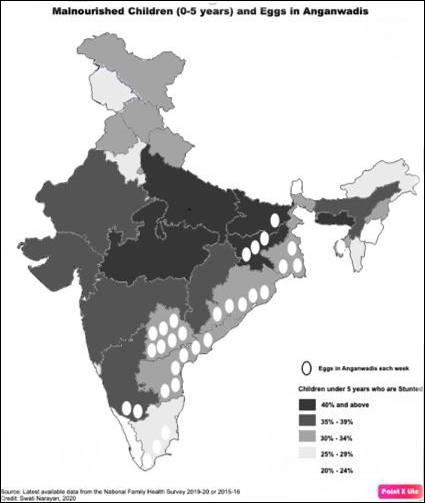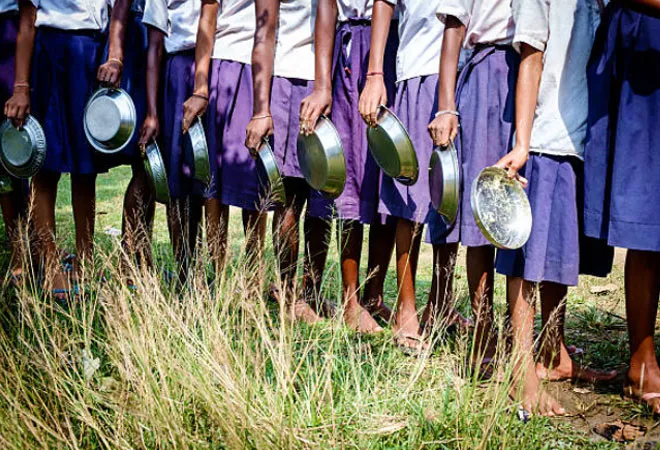Eggs are ‘super food’ with high quality protein and essential amino acids, good fats and best source for choline essential for metabolism. There is mounting evidence on the potential of egg in improving maternal and child health and nutrition, ending hunger, and achieving food security. Studies from Ecuador and Bangladesh show reduced prevalence of stunting and improved linear growth in children after consuming eggs every day. Early introduction of egg in complementary feeding can significantly improve growth in young children and contribute to global targets to reduce stunting. Improved dietary diversity and consumption animal source food are protective factor for stunting and underweight. In low- and middle-income countries, feeding animal sourced food to children is associated with better growth, cognitive performance, and motor development and activity.
Studies from Ecuador and Bangladesh show reduced prevalence of stunting and improved linear growth in children after consuming eggs every day.
Other than the enormous potential to improve child nutrition, eggs have the lowest environmental impacts, making it a sustainable means of supporting physical and cognitive development and reducing malnutrition in children. Despite impressive growth in egg production in the last decade, there is widespread variation in egg consumption across countries. According to Food and Agriculture Organization (FAO), China is the world’s largest producer of eggs with 37% of global production, followed by the United States and India with just 7% and 6%. Despite being the third largest producer of eggs, only one-third Indian households reportedly consume eggs. Rural household had a very low per capita consumption of eggs (1.94/month) as compared to urban (3.18/month).
According to the 2016-18 comprehensive nutrition survey, only 16% children aged 2 to 4 years ate eggs making it the least consumed food among them. Among school-going children between 5 and 9 years of age and adolescents (10-19 years), 35% consumed eggs. There was widespread interstate variation in egg consumption in children under 5 years (See Figure 1) with the highest (70.8%) being in Meghalaya and lowest at 2.8% in Haryana. Children residing in urban households consumed more eggs (22%) as compared to rural (14%). Christian children had the highest consumption of egg (33%), followed by Muslims (23.3%) and lowest among Sikh (14.9%) and Hindu (13.4%). Factors including cultural beliefs, mother’s education status and household income influenced the food consumption. Looking at the type of diet consumed by children, both 0-4 and 5-9 years old children consumed vegetarian food with egg diet at 6.2% and 8.5%.
 Egg consumption among children aged 2-4 years across Indian states.
Egg consumption among children aged 2-4 years across Indian states.
The Integrated Child Development Scheme and Mid-Day Meal Scheme are flagship programmes of the Indian government to improve the nutritional status of children and reduce incidence of malnutrition. The aim is to bridge the gap between the recommended dietary allowance and the average daily intake by children. Despite all this, malnutrition is alarming in India, with prevalence of stunted, underweight, and wasted children under 5 years of age was at 35.5%, 32.1%, 19.3%. Child malnutrition is the cause of 15% of India’s disease burden and 4% loss on GDP. Further alarming to note is that less than 50% children are introduced complementary feeding at 6-8 months and only 11.3% receive a minimum adequate diet (children receiving 4 or more food groups and a minimum meal frequency).
The Integrated Child Development Scheme and Mid-Day Meal Scheme are flagship programmes of the Indian government to improve the nutritional status of children and reduce incidence of malnutrition.
An analysis of NFHS-4 data to ascertain the role of complementary feeding in India’s high child malnutrition rates indicates feeding children animal-sourced and Vitamin A-rich food to be associated with lower malnutrition rates. Feeding children with eggs was found to lower risk of stunting. Only 16% children below 2 years of age consume animal source foods, according to the 2015-16 national survey.
Observational studies have shown strong association of consumption of animal source foods in combatting double burden of malnutrition and need for enhancing affordability and access to low income households through policy interventions. An analysis of Maharashtra’s nutrition survey indicated lower consumption of eggs to be associated with a two-fold increased odds of stunting in children 6-23 months old.
Despite the well-known benefits, the egg debate continues. The map indicates the harsh reality of states with high prevalence of stunting in children under 5 years of age and no provision of eggs at the Anganwadi centres.
 The map indicates high prevalence of stunting in children under 5 years of age and no provision of eggs at Anganwadi centres.
The map indicates high prevalence of stunting in children under 5 years of age and no provision of eggs at Anganwadi centres.
The National Human Rights Commission recommends inclusion of protein-rich foods such as eggs and milk in the Mid-Day Meal and at Anganwadi centres. In order to improve dietary diversity, guidelines have been issued by Integrated Child Development Services (ICDS), National Rural Livelihood Mission, and the education sector for the establishment of kitchen gardens for homestead seasonal vegetable production. Through these systems, production of animal source food (ASF) items such as, eggs, dairy, fish and other flesh foods, if culturally acceptable, need to be promoted as important complementary feeds. There is a need to promote daily consumption of one full egg by a child from six months of age. The National Institute of Nutrition recommends ‘egg as a complete food for children’.
Well‐informed social marketing and behaviour change communication strategies have led to a large increase in egg consumption among young children.
Under the supplementary food component of ICDS, states such as Odisha, Jharkhand, Tamil Nadu, Telangana, Karnataka, Andhra Pradesh, West Bengal, Tripura and Bihar supply boiled eggs to children (1-7 eggs/week). The mid-day meals in Jammu & Kashmir, Uttarakhand, Bihar, Assam, Kerala, Tripura, West Bengal, Jharkhand, Odisha, Telangana, Andhra Pradesh and Tamil Nadu provide eggs (1-5 eggs/week) in schools. Some of these states/UTs, Odisha, Jharkhand, Bihar, Uttarkhand, Jammu & Kashmir show marked improvement in stunting rates in under 5 children.
We have enough evidence to understand the potential of a simple egg to fight malnutrition. At the same time, we cannot ignore the poor purchasing power or poverty that adversely influences access to quality diversified food. Cultural factors and ignorance and the lack of knowledge also play an important role in the consumption of eggs by women and children. Well‐informed social marketing and behaviour change communication strategies have led to a large increase in egg consumption among young children.
The ‘POSHAN Abhiyaan’, launched in 2018, leverages on ‘Social Behavior Change Communication’ to enhance diet adequacy and can push for healthier nutrition behaviours through focused campaigns.
This commentary originally appeared in News18.
The views expressed above belong to the author(s). ORF research and analyses now available on Telegram! Click here to access our curated content — blogs, longforms and interviews.






 PREV
PREV


